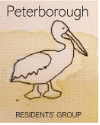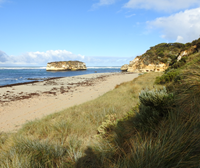Along the coastline are specially designed zones that transition into the wetland area and beyond, these zones are designed to withstand the forces that define a coastal environment. As you would no doubt guess, salt and wind is the dominant environmental force influencing plants, and of course the soils also have their role in determining what survives along our wild coastline.
Each of the zones described below is the home to distinct flora and this in turn means that the birds and animals that live within these zones are specific to those areas. For example, the Rufus Bristlebird that lives only in our part of the world, inhabits the shrublands that defines the zone we call here, the Foredunes. It can also be found in dense undergrowth into those patches where shrubs and bushes provide sufficient cover within the more heavily treed zone.
The unique features of these various zones is described briefly below:
Zone 1: Frontal Sand Dunes
On the frontal sand dunes Marram Sea Grass, Sea Rocket, Sea Spurge and Spinifex are found. Of these, all but the Spinifex has been introduced. The Marram grass was brought in deliberately, the other two are true weeds, opportunistic colonisers. The Marram was planted all along the Victorian Coast to stabilize moving sands. Interestingly it does this so well that it changes the shape of the coastline sand, giving steep profiles rather than the gentle slopes that Spinifex creates. Spinifex is a beautiful grass with soft, silver haired leaves and the distinctive tumbleweed seed spreader that is 30cm or more across, and it is harder to cultivate than it looks!
On the inland side of the sand dunes, we begin to find Knobby Club Rush, Flax Lily and Coastal Tussock Grass. The Coastal Tussock Grass has an iconic status in botanical classification, where groups of plants are named after representative species. It's name is Poa Poiformis in the Poaseae family. This is the grass family which includes Wheat, Rice, Rye Grass, Kikuyu and all other grasses. The Coastal Tussock Grass is the architypal grass, it is there front and centre representing all other grasses.
Zone 2: Foredunes
In the second zone in from the coast shrubs are to be found and here the daisy group dominate. All the members of the daisy family have fluffy seeds, so local seed collectors refer to it as 'coastal fluff', they have bristly parachutes attached to the seeds, just the same as thistles and dandelions. Here we find the Coast Daisy Bush, Everlasting Daisy and the Coast Cushion Bush. Allegedly, the local fisherfolk would rip up the cushion bush to sit on - in doing, so naming it. Other common plants found in this zone are the local Coastal Wattle, and Beard Heath with its tasty white fruit in abundance in January.
We are proud to see local plants like the Coast Cushion Bush adapted into the horticultural industry, the Coast Cushion Bush can now be bought in garden nurseries. It has a fine grey foliage and a tight habit making it a shapely bush and it looks good in gardens.
Coastal Wattle is a plant subject to controversy. It is a native plant, yet it has spread to such an extent as to cause changes to vegetation structure, major declines in species richness, and a loss of habitat for threatened flora and fauna. In the Bay of Islands Coastal Park volunteers regularly work to try to keep the impact of the Coastal Wattle down and Parks Victoria have undertaken action to reduce the growth of Coastal Wattle. However, in the Port Campbell National Park, west of the estuary, the Coastal Wattle is allowed to run rampant. (download here for further information).
Less commonly seen is the Sea Box with its not so tasty red berries, which should be avoided. The Sea Box belongs to the family Apocinaceae, which includes the highly toxic Oleander. The Sea Box is a really attractive plant: it's bright green, tight glossy leaves, a conspicuous flower and bright red berries and is easily shaped and hedged.
Zone 3: Pre Woodlands
Immediately behind this shrubland begins the woodland area where the less tall trees dominate. There are the Eucalypts such as: Stringybark, Manna Gums, Swamp Gums and Peppermint Gums. there are Wattles such as: Melaleucas, Blackwood Wattles and Tea Trees.
The only tree to stand tall in the area close to the coast is the Drooping She Oak (Casuarina). This tree is particularly designed to withstand the coastal environment. The pores of the tree are in channels in the needle shaped leaves which are also protected by a mat of hairs across the channels.





